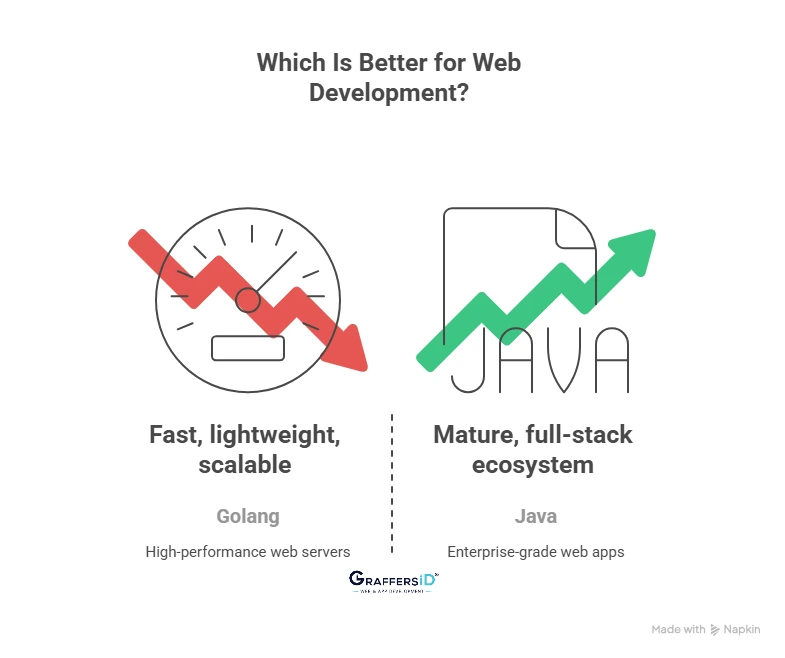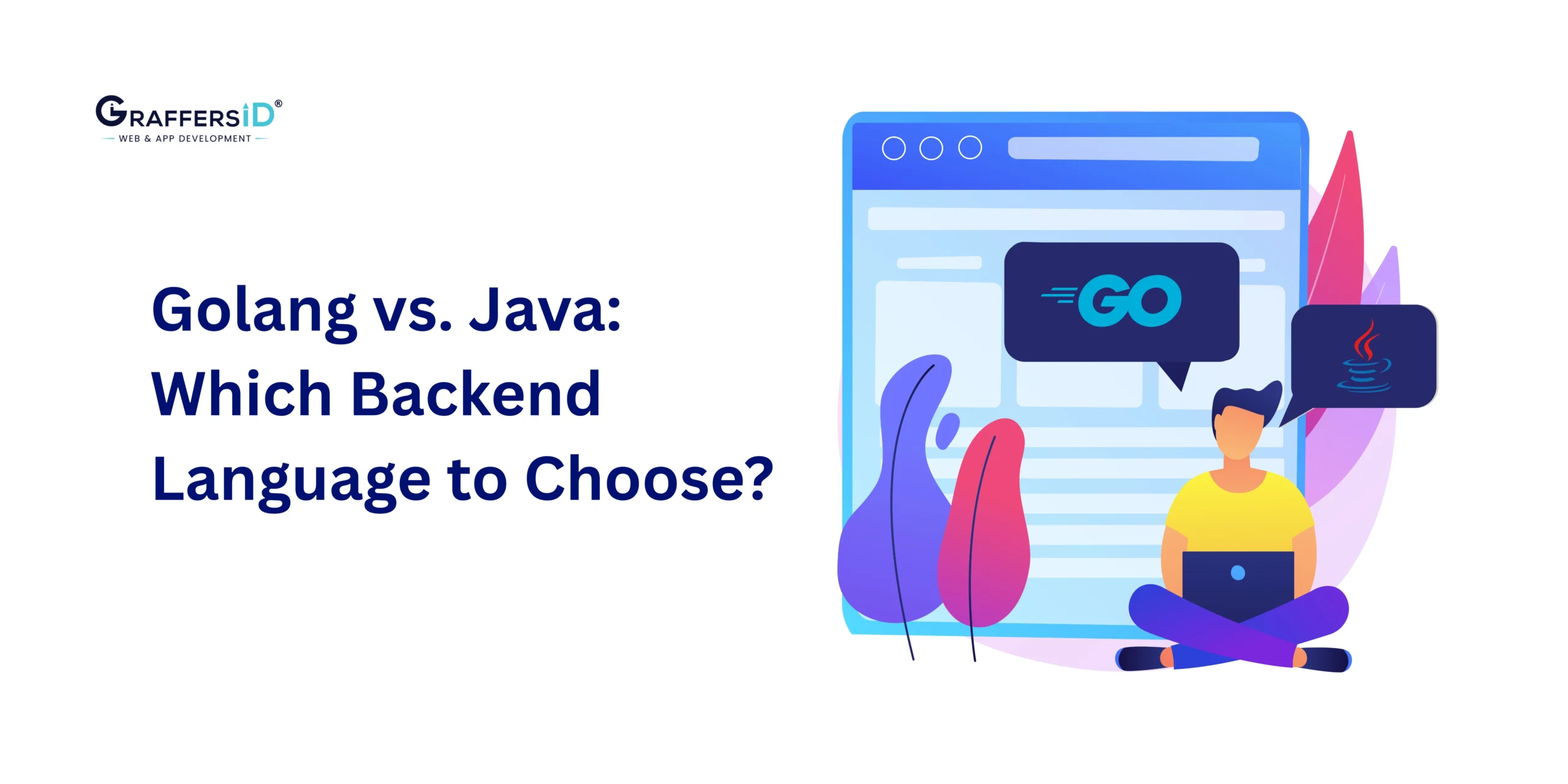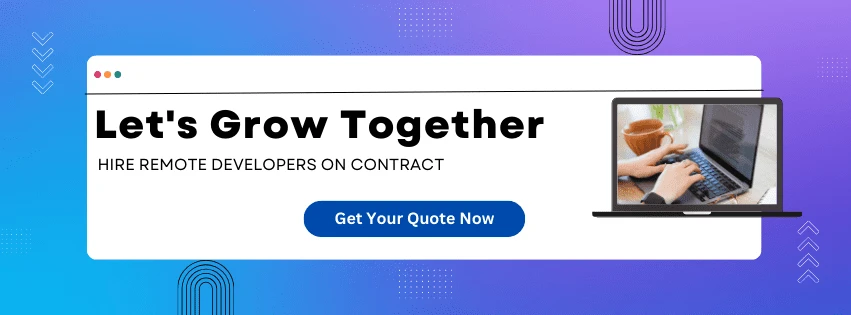By 2026, software performance and scalability have become the foundation of digital competitiveness. From AI-driven automation to real-time cloud applications, companies are racing to adopt languages that deliver both speed and reliability at scale.
As businesses modernize their tech stacks, one debate continues to shape engineering strategy: Should your team choose Golang, the high-performance, cloud-native powerhouse, or stay with Java, the battle-tested enterprise giant?
Both languages have evolved significantly in recent years. Golang now dominates the cloud-native and microservices ecosystem, while Java continues to lead in enterprise-grade, AI-enabled systems.
This 2026 comparison dives deep into Golang vs. Java, analyzing performance benchmarks, AI integration, scalability, developer productivity, and real-world use cases, so you can confidently decide which language is right for your next-generation project.
What Is Golang in 2026?
Golang (Go) is an open-source programming language built by Google to simplify modern software development. It’s known for its speed, scalability, and ease of use, making it a top choice for cloud-native apps, backend systems, and DevOps tools.
Key Features of Golang

-
Compiled and Fast: Golang is a statically typed, compiled language that delivers near-native performance for high-speed execution.
-
Simple and Readable: It has a C-like syntax but fewer keywords, making it clean, easy to learn, and efficient for developers.
-
Built for Concurrency: Go’s goroutines and channels enable thousands of concurrent tasks, ideal for scalable and real-time applications.
-
Memory Safe and Efficient: Automatic garbage collection ensures efficient memory use and safer code execution.
-
Lightweight and Portable: Go produces small, self-contained binaries that run smoothly across platforms and devices.
Why Go Matters in 2026?
Go has matured into a backbone for modern cloud infrastructure, from Kubernetes and Docker to AI model serving platforms. Its concurrency model and fast compile times make it perfect for real-time APIs, edge computing, and automation tools.
💡 Did You Know?
In 2026, Go ranks among the top 5 languages used for developing AI-enabled backend systems due to its speed and thread efficiency.
What Is Java in 2026?
Java, launched by Sun Microsystems in 1995, remains one of the most enduring and widely adopted programming languages in the world. It’s known for its platform independence, robust libraries, and unmatched reliability for enterprise-scale applications.
Key Features of Java

-
Object-Oriented and Reliable: Java’s class-based, object-oriented design ensures scalability, reusability, and clean architecture.
-
Runs Anywhere with JVM: Its “write once, run anywhere” capability through the JVM makes Java ideal for cross-platform development.
-
Rich Framework Ecosystem: Frameworks like Spring Boot, Hibernate, and Jakarta EE 11 empower developers to build secure, cloud-ready applications faster.
-
Automatic Memory Management: Built-in garbage collection and runtime optimization enhance performance and stability.
-
Massive Developer Community: A mature ecosystem and global support make Java a long-term, future-proof choice for enterprises.
Why Java Remains Relevant in 2026?
Despite newer languages, Java’s ecosystem keeps evolving. With Project Loom, GraalVM, and Jakarta EE 11, Java continues to compete with modern languages like Go in cloud-native and AI-integrated environments.
💡 Did You Know?
Over 60% of AI-powered enterprise platforms and FinTech systems still rely on Java for dependable performance and integration with AI frameworks.
Golang vs. Java: Full Comparison (2026 Update)
| Feature | Golang | Java |
|---|---|---|
| Typing | Static, procedural | Static, fully object-oriented |
| Syntax | Minimal, easy to write | Verbose but flexible |
| Performance | Compiled to machine code (very fast) | JVM adds some overhead |
| Concurrency | Lightweight goroutines | Threads + Project Loom (fibers) |
| Memory Usage | Low memory footprint | Heavier memory usage |
| Cross-Platform | Needs platform-specific binaries | Write once, run anywhere (JVM) |
| Learning Curve | Quick and simple | Steeper for beginners |
| Community Support | Growing, Google-backed | Massive global ecosystem |
| Best Use Cases | Cloud-native apps, microservices, DevOps | Enterprise apps, Android, web apps |
Golang vs. Java: Key Differences Explained
1. Performance
- Golang compiles directly to machine code, making it faster and more efficient than JVM-based execution.
- Java, however, is closing the gap with GraalVM and Project Loom, optimizing startup time and concurrency.
2. Concurrency
- Go’s goroutines offer lightweight parallelism ideal for microservices.
- Java’s Loom fibers now provide similar capabilities but with more configuration overhead.
3. Development Speed
- Golang’s minimal syntax accelerates development.
- Java developers benefit from robust frameworks that simplify enterprise-grade application building.
4. Scalability
Both scale well, but Go’s concurrency makes it more suitable for real-time systems and cloud-based workloads.
Read More: How to Select the Right AI Tech Stack for Web Development?
Golang Trends in 2026
-
Go + AI Integration: Developers increasingly use Go for AI model serving and inference optimization, due to its efficient concurrency model.
-
Cloud-Native First Approach: Go remains the dominant choice for Kubernetes, Docker, and microservice orchestration tools.
-
Edge and IoT Development: Go’s small binary footprint makes it perfect for IoT and edge computing solutions.
-
Go Modules 2.0: New dependency management tools enhance reproducibility and CI/CD integration.
-
Quantum-Ready Frameworks: Early experiments leverage Go’s determinism for quantum-safe algorithmic simulations.
Java Trends in 2026
-
Project Loom Maturity: Loom brings lightweight concurrency, significantly improving Java’s performance in multi-threaded applications.
-
GraalVM Adoption: GraalVM boosts Java’s runtime efficiency by compiling to native binaries, reducing JVM startup delays.
-
Jakarta EE 11 Evolution: Enables cloud-native and containerized enterprise systems with better DevOps support.
-
Kotlin Coexistence: Java teams increasingly use Kotlin for modern JVM-based projects, maintaining full interoperability.
-
AI-Enhanced Development Tools: Tools like GitHub Copilot and AWS CodeWhisperer integrate smoothly with Java IDEs for productivity.
Read More: Top Trends in Web Development Shaping the Digital World
Which Performs Better in 2026? Golang vs. Java
- Golang wins for raw performance, faster execution, and memory efficiency, making it ideal for high-throughput microservices and real-time systems.
- Java holds strong for enterprise reliability, mature tooling, and scalability, especially in cloud and AI-driven enterprise environments.
Verdict:
If you need fast, concurrent APIs or cloud-native services, go with Golang. If your system demands complex logic, legacy integration, or enterprise compliance, Java remains unbeatable.
Best Use Cases of Golang and Java in 2026

When to Use Golang in 2026
-
Cloud-Native Apps: Ideal for building scalable, cloud-first applications on AWS, Azure, or GCP.
-
Microservices: Perfect for containerized architectures that demand high concurrency and fast deployment.
-
Real-Time Systems: Great for chat, streaming, and live gaming apps that need low-latency performance.
-
DevOps Tools: Widely used for creating automation tools like Docker, Kubernetes, and Terraform.
-
IoT & Edge Devices: Efficient for low-resource environments with fast execution and minimal overhead.
-
AI Model Serving: Excellent for deploying AI inference services with lightweight, high-performance APIs.
When to Use Java in 2026
-
Enterprise Software: Best for large-scale CRM, ERP, and legacy systems requiring robust reliability.
-
Mobile & Cross-Platform Apps: Core language for Android and JVM-based applications.
-
FinTech & Banking: Trusted by financial institutions for secure, transaction-heavy systems.
-
Big Data & Analytics: Integrates smoothly with tools like Hadoop and Spark for data processing.
-
Long-Term Projects: Ideal for systems needing extensive community support and backward compatibility.
-
AI-Powered Enterprises: Strong choice for AI-driven platforms using JVM-based frameworks and APIs.
Read More: The Role of AI in Web Development
How AI Is Changing the Golang vs. Java Comparison in 2026?
1. Smarter Development with AI Tools
AI coding assistants like Copilot X, Tabnine, and Replit Ghostwriter now streamline development in both Go and Java, automating code generation, refactoring, and testing to speed up delivery cycles.
2. AI Workload Performance and Optimization
Java remains a top choice for building and managing AI pipelines and machine learning training, while Golang leads in AI model deployment and real-time inference across distributed systems.
3. AI-Powered DevOps and CI/CD
Go’s faster build time supports AI-driven CI/CD workflows with predictive deployment insights, while Java’s monitoring ecosystem, powered by tools like New Relic AI, enhances reliability in enterprise-scale production.
Which Is Better for Web Development in 2026: Golang or Java?
Both Golang and Java remain top choices for backend development in 2026. The right pick depends on your project’s speed, scalability, and integration needs with AI, automation, and cloud systems.

Choose Golang if:
-
You want a fast, lightweight, and scalable backend for high-performance web servers.
-
Your architecture relies on microservices, RESTful APIs, or gRPC for distributed systems.
-
You’re deploying on Kubernetes, Docker, or serverless environments for modern scalability.
-
You need built-in concurrency to handle thousands of simultaneous requests efficiently.
-
You’re building automation tools or cloud-native products for startups or DevOps ecosystems.
Choose Java if:
-
You need a mature, full-stack ecosystem with frameworks like Spring Boot or Hibernate.
-
Your app must run smoothly across platforms via JVM-based environments.
-
You’re developing enterprise-grade web apps that demand high security and long-term reliability.
-
You want smooth integration with legacy or existing enterprise systems.
-
You’re in sectors like FinTech, logistics, or healthcare, where compliance and robustness are crucial.
Conclusion: Golang vs. Java: Which Is the Right Choice for Your Project in 2026?
In 2026, both Golang and Java stand as top-tier backend languages, each excelling in different business environments.
Golang dominates where speed, scalability, and cloud-native performance matter most, making it ideal for modern web servers, microservices, and automation tools.
Java, on the other hand, remains the trusted choice for enterprise-grade applications, powering complex financial, healthcare, and logistics systems with unmatched reliability and security.
The real question for CTOs and tech leaders isn’t which language is better, but which one aligns with your business goals, scalability roadmap, and AI readiness strategy.
At GraffersID, we help startups and enterprises build high-performing, scalable, and AI-ready web and app solutions using the best-fit technologies.
Hire remote developers from GraffersID and build your next product.





